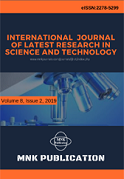DOI:10.29111/ijlrst ISRA Impact Factor:3.35, Peer-reviewed, Open-access Journal
Research Paper Open Access
International Journal of Latest Research in Science and Technology Vol.3 Issue 5, pp 1-5,Year 2014
Correspondence should be addressed to :
Received : 28 August 2014; Accepted : 14 September 2014 ; Published : 31 October 2014

| Download | 125 |
|---|---|
| View | 190 |
| Article No. | 10383 |
Grafting trees of similar botanical characteristics can produce a disease and environmental conditions resistant, and more productive plant. However, it is not known whether grafting affect the nutritional value of fruits. In the present study, the effect of grafting red tree tomato (Cyphomandra betacea Sendt.) on soda apple (Solanum aculeastrum) on nutritional value of fruit has been determined. The pH, titratable acidity, moisture, protein, fat, carbohydrates, ash, vitamin C, and mineral contents were determined using AOAC International approved Methods. Findings showed that there were no significant differences (P< 0.05) between parameters of grafted red tree tomato (GRTT) compared to no grafted red tree tomatoes (NGRTT). The pH values varied between 3.6±0.19 for GRTT and 3.8±0.27 for NGRTT. The titratable acidity ranged between 2.0±0.17 for GRTT and 1.8±0.10 for NGRTT. The moisture, protein, carbohydrates, fat, and ash contents ranged from 86.8±4.96, 2.0±0.20, 10.2±1.15, 1.2±0.06, and 0.84±0.04 for GRTT respectively; whereas the same values ranged from 87.1±3.66, 2.3±0.18, 10.7±1.91, 1.1±0.09, and 0.81±0.02 for NGRTT respectively. The vitamin C, phosphorus, magnesium, calcium, and iron contents varied from 22.0±1.73, 342.9±12.97, 60.2±5.03, 19.6±2.30, 9.2±1.45, and 0.45±0.03 for GRTT respectively; and the same values varied from 21.7±1.75, 345.6±13.36, 59.7±3.18, 19.9±2.70, 9.2±1.33, and 0.41±0.03 for NGRTT respectively. It is clear that grafting can be used to improve its production without affecting the nutritional value. Further research is required to study its protection potential against pest and diseases of tree tomato.
Copyright © 2014 Phénias Nsabimana et al. This is an open access article distributed under the Creative Commons Attribution 4.0 International (CC BY 4.0) license which permits unrestricted use, distribution, and reproduction in any medium, provided the original work is properly cited.
Phénias Nsabimana, Sylvestre Habimana, Consolée Musabwayire , " Effect Of Grafting Red Tree Tomato (cyphomandra Betacea Sendt.) On Soda Apple (solonacea Aculeastrum) On Nutritional Value Of Fruit ", International Journal of Latest Research in Science and Technology . Vol. 3, Issue 5, pp 1-5 , 2014

MNK Publication was founded in 2012 to upholder revolutionary ideas that would advance the research and practice of business and management. Today, we comply with to advance fresh thinking in latest scientific fields where we think we can make a real difference and growth now also including medical and social care, education,management and engineering.

We offers several opportunities for partnership and tie-up with individual, corporate and organizational level. We are working on the open access platform. Editors, authors, readers, librarians and conference organizer can work together. We are giving open opportunities to all. Our team is always willing to work and collaborate to promote open access publication.

Our Journals provide one of the strongest International open access platform for research communities. Our conference proceeding services provide conference organizers a privileged platform for publishing extended conference papers as journal publications. It is deliberated to disseminate scientific research and to establish long term International collaborations and partnerships with academic communities and conference organizers.